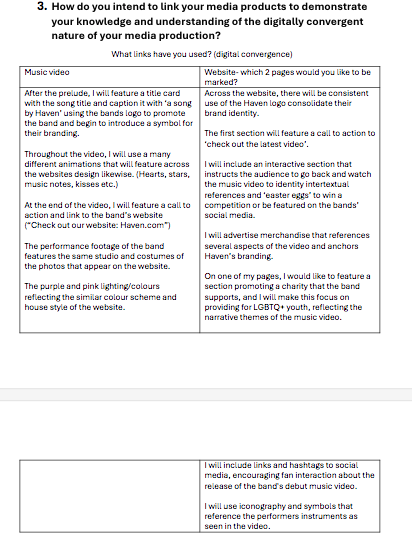Candidate Number- 1132 Centre Number-16607 Brief- 4 Music Video and Online
Wednesday, December 11, 2024
Website Final Submission
Website Link
My working pages are the 'Home' page and the 'About' page.
My website was designed and created on an Apple Mac computer, meaning the proportions when viewed on a regular PC may differ. To ensure the correct features appear as designed, I have also included screenshots of what the website should optimally look like.
Home Page:
About Page:
Tuesday, December 10, 2024
Statement of Intent
Statement of Intent
How do you intend to use the four areas of the media theoretical framework to communicate meaning and meet the requirements of your chosen brief? (approx. 400 words)
Product 1-
For my music video, I intend to construct an entertaining narrative that resonates with a young adult audience alongside an upbeat performance which founds a strong brand identity for my band, as typically produced by many artists signed to Universal. I wish to follow the storyline of a queer, young female protagonist (the band’s lead singer) meeting another girl at the beginning of the video and subsequently imagining a relationship with her through the lens of several popular romance films such as ‘500 Days of Summer’ and ‘The Fault In Our Stars’. However, to create an interesting narrative which engages an audience that ‘likes to be entertained’ my protagonists' idealistic visions of love are thwarted by a subversive resolution to the storyline. Also, by using an array of shot types and dynamic camera work, I hope to fulfill expectations of entertainment with a fun and fast paced video.
By paying homage to these popular romance films and parodying recognisable scenes, my music video will be a post-modern product that offers gratification to a middle market audience who will understand these references that are currently trending in a contemporary zeitgeist. As well as a narrative that revolves around teenage romance, a theme piquing the interest of a 16–25-year-old audience, I also intend to represent young women of different ethnicities in the rock scene, a genre typically dominated by men. This followed by a queer narrative hopefully naturalises representations usually omitted from mainstream media; a method of transcoding discussed in Stuart Hall’s representation theory.
Product 2-
Through my website, I wish to provide synergy with my first product and emphasise the brand identity of my fictional band through a cohesive house style and interactive elements. I hope to utilise media language techniques and feature various original images that establish visual codes consistent to the video product such as mise-en-scene, lighting, setting and costume. I also intend to employ typical website conventions such as digital pop-ups and hidden easter eggs to promote my artist commercially through merchandise sales and issue ‘star personas’ (as theorised by Richard Dyer).
Universal typically uses cross-media convergence to extensively promote artists, and I wish to emulate this by advocating for the band's presence on social media platforms such as TikTok and Instagram. I plan to include an audio visual that takes the format of a TikTok-style interview which helps further the star representation of the musicians and appeal to a young audience with large presences on this platform.
My website platform will also provide several opportunities for audience interaction as I intend to include a section that features ‘Fans of the Week’, showcasing social media posts from followers who use a certain hashtag that references the band.
How do you intend to link your media products to demonstrate your knowledge and understanding of the digitally convergent nature of your media production? (approx. 100 words)
To create a coherent sense of brand identity, I intend to include various connections between both of my products. These will not only include a clear house style with consistent colour schemes, logos and animations, but intertextual references and interactive links. Each product will directly reference one another and provide the digitally native 16–25-year-old target audience the opportunity for interaction, encouraging viewer participation in competitions and social media involvement associated with the video. I also plan to reflect the LGBT+ narrative within my video and promote a collaboration with a fictitious charity on my website called the ‘Youth Pride Trust’. Appealing to possible ‘fans’ of the band, I also wish to advertise merchandise via my website that alludes to the video and anchors the band’s branding, reflecting the industrial and commercial aims of a Universal artist.

























